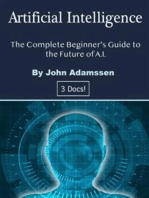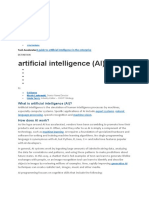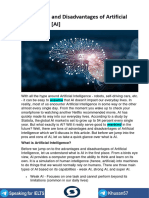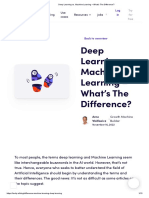Professional Documents
Culture Documents
wHAT IS ARTIFICIAL INTELLIGENCE
wHAT IS ARTIFICIAL INTELLIGENCE
Uploaded by
Salah Iflis ZaarirCopyright
Available Formats
Share this document
Did you find this document useful?
Is this content inappropriate?
Report this DocumentCopyright:
Available Formats
wHAT IS ARTIFICIAL INTELLIGENCE
wHAT IS ARTIFICIAL INTELLIGENCE
Uploaded by
Salah Iflis ZaarirCopyright:
Available Formats
What is AI technology in simple words?
Artificial intelligence (AI) refers to computer systems capable of performing complex tasks that historically only a human
could do, such as reasoning, making decisions, or solving problems.3 avr. 2024
What Is Artificial Intelligence? Definition, Uses, and Types
Artificial intelligence (AI) refers to computer systems capable of performing complex tasks that
historically only a human could do, such as reasoning, making decisions, or solving problems.Today, the
term “AI” describes a wide range of technologies that power many of the services and goods we use every
day – from apps that recommend tv shows to chatbots that provide customer support in real time. But do
all of these really constitute artificial intelligence as most of us envision it? And if not, then why do we use
the term so often? In this article, you’ll learn more about artificial intelligence, what it actually does, and
different types of it. In the end, you’ll also learn about some of its benefits and dangers and explore flexible
courses that can help you expand your knowledge of AI even further.
What is artificial intelligence?
Artificial intelligence (AI) is the theory and development of computer systems capable of performing
tasks that historically required human intelligence, such as recognizing speech, making decisions, and
identifying patterns. AI is an umbrella term that encompasses a wide variety of technologies,
including machine learning, deep learning, and natural language processing (NLP).Although the term is
commonly used to describe a range of different technologies in use today, many disagree on whether
these actually constitute artificial intelligence. Instead, some argue that much of the technology used in the
real world today actually constitutes highly advanced machine learning that is simply a first step towards
true artificial intelligence, or “general artificial intelligence” (GAI).Yet, despite the many philosophical
disagreements over whether “true” intelligent machines actually exist, when most people use the
term AI today, they’re referring to a suite of machine learning-powered technologies, such as Chat GPT or
computer vision, that enable machines to perform tasks that previously only humans can do like
generating written content, steering a car, or analyzing data.
Artificial intelligence examples
Though the humanoid robots often associated with AI (think Star Trek: The Next Generation’s Data
or Terminator’s T-800) don’t exist yet, you’ve likely interacted with machine learning-powered services or
devices many times before.
At the simplest level, machine learning uses algorithms trained on data sets to create machine learning
models that allow computer systems to perform tasks like making song recommendations, identifying the
fastest way to travel to a destination, or translating text from one language to another. Some of the most
common examples of AI in use today include:
ChatGPT: Uses large language models (LLMs) to generate text in response to questions or comments
posed to it.
Google Translate: Uses deep learning algorithms to translate text from one language to another.
Netflix: Uses machine learning algorithms to create personalized recommendation engines for users
based on their previous viewing history.
Tesla: Uses computer vision to power self-driving features on their cars.
AI in the workforce
Artificial intelligence is prevalent across many industries. Automating tasks that don't require human
intervention saves money and time, and can reduce the risk of human error. Here are a couple of ways AI
could be employed in different industries:
Finance industry. Fraud detection is a notable use case for AI in the finance industry. AI's capability to
analyze large amounts of data enables it to detect anomalies or patterns that signal fraudulent behavior.
Health care industry. AI-powered robotics could support surgeries close to highly delicate organs or
tissue to mitigate blood loss or risk of infection.
What is artificial general intelligence (AGI)?
Artificial general intelligence (AGI) refers to a theoretical state in which computer systems will be able to
achieve or exceed human intelligence. In other words, AGI is “true” artificial intelligence as depicted in
countless science fiction novels, television shows, movies, and comics.
As for the precise meaning of “AI” itself, researchers don’t quite agree on how we would recognize
“true” artificial general intelligence when it appears. However, the most famous approach to identifying
whether a machine is intelligent or not is known as the Turing Test or Imitation Game, an experiment that
was first outlined by influential mathematician, computer scientist, and cryptanalyst Alan Turing in a 1950
paper on computer intelligence. There, Turing described a three-player game in which a human
“interrogator” is asked to communicate via text with another human and a machine and judge who
composed each response. If the interrogator cannot reliably identify the human, then Turing says the
machine can be said to be intelligent [1].
To complicate matters, researchers and philosophers also can’t quite agree whether we’re beginning to
achieve AGI, if it’s still far off, or just totally impossible. For example, while a recent paper from Microsoft
Research and OpenAI argues that Chat GPT-4 is an early form of AGI, many other researchers are
skeptical of these claims and argue that they were just made for publicity [2, 3].
Regardless of how far we are from achieving AGI, you can assume that when someone uses the term
artificial general intelligence, they’re referring to the kind of sentient computer programs and machines that
are commonly found in popular science fiction.
The 4 Types of AI
As researchers attempt to build more advanced forms of artificial intelligence, they must also begin to
formulate more nuanced understandings of what intelligence or even consciousness precisely mean. In
their attempt to clarify these concepts, researchers have outlined four types of artificial intelligence.
Here’s a summary of each AI type, according to Professor Arend Hintze of the University of Michigan [4]:
1. Reactive machines
Reactive machines are the most basic type of artificial intelligence. Machines built in this way don’t
possess any knowledge of previous events but instead only “react” to what is before them in a given
moment. As a result, they can only perform certain advanced tasks within a very narrow scope, such as
playing chess, and are incapable of performing tasks outside of their limited context.
2. Limited memory machines
Machines with limited memory possess a limited understanding of past events. They can interact more
with the world around them than reactive machines can. For example, self-driving cars use a form of
limited memory to make turns, observe approaching vehicles, and adjust their speed. However, machines
with only limited memory cannot form a complete understanding of the world because their recall of past
events is limited and only used in a narrow band of time.
3. Theory of mind machines
Machines that possess a “theory of mind” represent an early form of artificial general intelligence. In
addition to being able to create representations of the world, machines of this type would also have an
understanding of other entities that exist within the world. As of this moment, this reality has still not
materialized.
4. Self-aware machines
Machines with self-awareness are the theoretically most advanced type of AI and would possess an
understanding of the world, others, and itself. This is what most people mean when they talk about
achieving AGI. Currently, this is a far-off reality.
AI benefits and dangers
AI has a range of applications with the potential to transform how we work and our daily lives. While many
of these transformations are exciting, like self-driving cars, virtual assistants, or wearable devices in the
healthcare industry, they also pose many challenges.
It’s a complicated picture that often summons competing images: a utopia for some, a dystopia for others.
The reality is likely to be much more complex. Here are a few of the possible benefits and dangers AI may
pose:
Potential Benefits Potential Dangers
Greater accuracy for certain repeatable
tasks, such as assembling vehicles or Job loss due to increased automation.
computers.
Potential for bias or discrimination as a
Decreased operational costs due to
result of the data set on which the AI is
greater efficiency of machines.
trained.
Increased personalization within digital
Possible cybersecurity concerns.
services and products.
Improved decision-making in certain Lack of transparency over how decisions
situations. are arrived at, resulting in less than optimal
Potential Benefits Potential Dangers
solutions.
Potential to create misinformation, as well
Ability to quickly generate new content,
as inadvertently violate laws and
such as text or images.
regulations.
These are just some of the ways that AI provides benefits and dangers to society. When using new
technologies like AI, it’s best to keep a clear mind about what it is and isn’t. With great power comes great
responsibility, after all.
Read more: AI Ethics: What It Is and Why It Matters
You might also like
- Chem Well T Operator's Manual PDFDocument210 pagesChem Well T Operator's Manual PDFAlejandro Palomino AmaroNo ratings yet
- Ai101guide 190430154655 PDFDocument34 pagesAi101guide 190430154655 PDFSajan Mathew67% (3)
- Artificial Intelligence: The Complete Beginner’s Guide to the Future of A.I.From EverandArtificial Intelligence: The Complete Beginner’s Guide to the Future of A.I.Rating: 4 out of 5 stars4/5 (5)
- Dataprocessing Ss3 Mock 2nd TermDocument10 pagesDataprocessing Ss3 Mock 2nd Termmoneydey aroloyeNo ratings yet
- Living in The It EraDocument21 pagesLiving in The It EraJamaica AngotNo ratings yet
- Ai What It IsDocument9 pagesAi What It IsSalaheddine AnamirNo ratings yet
- Anto Project 1Document9 pagesAnto Project 1antoprincia1723No ratings yet
- CollaboratingaiDocument9 pagesCollaboratingaiapi-670653600No ratings yet
- What Is Artificial IntelligenceDocument4 pagesWhat Is Artificial IntelligenceroblesangellemaeNo ratings yet
- Artificial Intelligence: Learning about Chatbots, Robotics, and Other Business ApplicationsFrom EverandArtificial Intelligence: Learning about Chatbots, Robotics, and Other Business ApplicationsRating: 5 out of 5 stars5/5 (3)
- Artificial IntelligenceDocument4 pagesArtificial IntelligenceNikko PandapatanNo ratings yet
- Cim ReportDocument18 pagesCim ReportMithil JoshiNo ratings yet
- Chap 2 AiDocument44 pagesChap 2 Aijhonmer.dormidoNo ratings yet
- Artificial Intelligence: Robots, Applications, and Machine Learning in a NutshellFrom EverandArtificial Intelligence: Robots, Applications, and Machine Learning in a NutshellRating: 5 out of 5 stars5/5 (3)
- Results 4.1 Impact of Artificial IntelligenceDocument15 pagesResults 4.1 Impact of Artificial IntelligenceTRIZZANo ratings yet
- Artificial Intelligence and Technology - Docx1Document4 pagesArtificial Intelligence and Technology - Docx1nderebasm2023No ratings yet
- Concept of Artificial Intelligence Its IDocument5 pagesConcept of Artificial Intelligence Its IobedNo ratings yet
- Artificial Intelligence and SecurityDocument12 pagesArtificial Intelligence and SecurityHiffsah NaikNo ratings yet
- What Is Artificial IntelligenceDocument14 pagesWhat Is Artificial IntelligenceBeanka PaulNo ratings yet
- Kepentigan IodfiosadfDocument11 pagesKepentigan IodfiosadfAkmal FaizNo ratings yet
- Artificial Intelligence in Different Field of LifeDocument3 pagesArtificial Intelligence in Different Field of LiferiteshNo ratings yet
- Whether or Not We Are Aware of It, Over Recent Years Artificial Intelligence (AI) Has Become An Integral Part of Our LivesDocument8 pagesWhether or Not We Are Aware of It, Over Recent Years Artificial Intelligence (AI) Has Become An Integral Part of Our Livesnaseebullah1990No ratings yet
- Artificial intelligence is based on the principle that human intelligence can be defined in a way that a machine can easily mimic it and execute tasks, from the most simple to those that are even more complexDocument3 pagesArtificial intelligence is based on the principle that human intelligence can be defined in a way that a machine can easily mimic it and execute tasks, from the most simple to those that are even more complexAngelique Keith Dulos PuaNo ratings yet
- Artificial IntelligenceDocument11 pagesArtificial Intelligencearya.salar151No ratings yet
- Introductory Chapter: Artificial Intelligence - Challenges and ApplicationsDocument5 pagesIntroductory Chapter: Artificial Intelligence - Challenges and ApplicationspranaysohamprabhaNo ratings yet
- Concept of Artificial IntelligenceDocument3 pagesConcept of Artificial IntelligenceavanthikancheriNo ratings yet
- Untitled DesignDocument11 pagesUntitled Designrd4678039No ratings yet
- Practice, Available atDocument30 pagesPractice, Available atkrisNo ratings yet
- What Is Artificial IntelligenceDocument3 pagesWhat Is Artificial IntelligencePreah GulatiNo ratings yet
- Artificial Intelligence (AI)Document14 pagesArtificial Intelligence (AI)Salaheddine Anamir100% (2)
- What Is Artificial IntelligenceDocument8 pagesWhat Is Artificial IntelligenceRukhsar TariqNo ratings yet
- Artificial IntelligenceDocument13 pagesArtificial Intelligenceheyimchad28No ratings yet
- Ai Research PaperDocument10 pagesAi Research PaperKash SharmaNo ratings yet
- Artificial Intelligence: How Machine Learning, Robotics, and Automation Have Shaped Our SocietyFrom EverandArtificial Intelligence: How Machine Learning, Robotics, and Automation Have Shaped Our SocietyRating: 4.5 out of 5 stars4.5/5 (4)
- Conceptsforauto IDocument23 pagesConceptsforauto ImskcegNo ratings yet
- Artificial Intelligence FINALDocument7 pagesArtificial Intelligence FINALHarshini ChandakNo ratings yet
- Artificial IntelligenceDocument49 pagesArtificial IntelligenceKristopher France PunioNo ratings yet
- Artificial Intelligence: Benefits and RisksDocument11 pagesArtificial Intelligence: Benefits and RiskssiwirNo ratings yet
- Artificial General IntelligenceDocument6 pagesArtificial General IntelligenceSanjayNo ratings yet
- Chapter 3 - Artificial Intelligence (AI)Document101 pagesChapter 3 - Artificial Intelligence (AI)Sam ContactNo ratings yet
- Unit I Introduction To Artificial IntelligenceDocument11 pagesUnit I Introduction To Artificial IntelligenceSE10SAKSHI CHAVANNo ratings yet
- Artificial IntelligenceDocument9 pagesArtificial Intelligencedomesoc447No ratings yet
- OFTW#2 - Emerging Technologies Artificial Intelligence (AI)Document8 pagesOFTW#2 - Emerging Technologies Artificial Intelligence (AI)depapcatNo ratings yet
- OFTW#2 - Emerging Technologies Artificial Intelligence (AI)Document8 pagesOFTW#2 - Emerging Technologies Artificial Intelligence (AI)depapcatNo ratings yet
- Importance of Securing Technologies With Artificial IntelligenceDocument27 pagesImportance of Securing Technologies With Artificial IntelligenceAbhi SigdelNo ratings yet
- Module 2 Section 5 AIDocument9 pagesModule 2 Section 5 AIElla MontefalcoNo ratings yet
- What Is Artificial Intelligence?Document3 pagesWhat Is Artificial Intelligence?Hùng MạnhNo ratings yet
- Artificial Intelligence: Data Analytics and Innovation for BeginnersFrom EverandArtificial Intelligence: Data Analytics and Innovation for BeginnersRating: 5 out of 5 stars5/5 (3)
- Artificial IntelligenceDocument8 pagesArtificial IntelligenceSaiful Islam PriyoNo ratings yet
- Individual Report123 - EditedDocument5 pagesIndividual Report123 - EditedArmish ArifNo ratings yet
- AI Question Bank-1Document13 pagesAI Question Bank-1Ullas GowdaNo ratings yet
- Artificial IntelligenceDocument12 pagesArtificial IntelligenceAyeshaNo ratings yet
- The Effects of Artificial Intelligence On HumansDocument17 pagesThe Effects of Artificial Intelligence On Humansanon_119606901100% (1)
- What Is Artificial IntelligenceDocument8 pagesWhat Is Artificial IntelligenceLuiz NunesNo ratings yet
- AI (Artificial Intelligence) : Expert Systems Speech Recognition Machine VisionDocument9 pagesAI (Artificial Intelligence) : Expert Systems Speech Recognition Machine VisionRasel moreNo ratings yet
- AI 2 PurposeDocument4 pagesAI 2 PurposeGayathri KodakandlaNo ratings yet
- ML 2Document8 pagesML 2Gayathri KodakandlaNo ratings yet
- Everything That You Are Curious To Know: by Sajan MathewDocument34 pagesEverything That You Are Curious To Know: by Sajan MathewSajan MathewNo ratings yet
- The AI Revolution: How Artificial Intelligence Is Reshaping Our Society For Better or WorseDocument4 pagesThe AI Revolution: How Artificial Intelligence Is Reshaping Our Society For Better or Worses2020804No ratings yet
- Benifits and Risks of AIDocument5 pagesBenifits and Risks of AIsaminionNo ratings yet
- Artificial Intelligence Unit - 1Document9 pagesArtificial Intelligence Unit - 1ratnesh gontiyaNo ratings yet
- Advantages and Disadvantages of Artificial IntelligenceDocument6 pagesAdvantages and Disadvantages of Artificial IntelligencepranavNo ratings yet
- Assignment 4Document6 pagesAssignment 4arnabbhai514No ratings yet
- 05 WebdynSunPM - EN - V13.11.2018Document2 pages05 WebdynSunPM - EN - V13.11.2018Linh Nguyễn KhắcNo ratings yet
- HCM - PER - Frequently Asked Questions & Troubleshooting Guide - ChecklistsDocument33 pagesHCM - PER - Frequently Asked Questions & Troubleshooting Guide - ChecklistsSadiqNo ratings yet
- TVL - CSS12 - Q2 - DW8Document3 pagesTVL - CSS12 - Q2 - DW8Sergio B. Goco Jr.No ratings yet
- En System Current GenEM BookDocument396 pagesEn System Current GenEM Bookivanrisa2525No ratings yet
- Example - AC500+S500FDPDocument41 pagesExample - AC500+S500FDPSusanta royNo ratings yet
- PPS25 PDFDocument1 pagePPS25 PDFflo basukiNo ratings yet
- Speech Mentor For Visually ImpairedDocument10 pagesSpeech Mentor For Visually Impairedsahithi panduNo ratings yet
- Deep Learning vs. Machine Learning - What's The DifferenceDocument13 pagesDeep Learning vs. Machine Learning - What's The DifferencemalcNo ratings yet
- Mimosa Scheduling Software: Tutorial For BeginnersDocument53 pagesMimosa Scheduling Software: Tutorial For BeginnersKURIKULUMNo ratings yet
- Red Team OperationsDocument15 pagesRed Team OperationsMarcelo JuniorNo ratings yet
- Tutorial 5: 3.0 File Management: Learning OutcomesDocument7 pagesTutorial 5: 3.0 File Management: Learning OutcomesNavinaash Chanthra SegaranNo ratings yet
- EziWeigh6 User Manual (En) - 0Document16 pagesEziWeigh6 User Manual (En) - 0Taller ElectrónicoNo ratings yet
- Online Diagnostic Lab Reporting SystemDocument76 pagesOnline Diagnostic Lab Reporting SystemCabdicasiis CabdinuurNo ratings yet
- MIS10 ch06Document15 pagesMIS10 ch06Malik Haroon KarimNo ratings yet
- FidBond Enrolment Form Template Pinaka Bago PassiNHSDocument7 pagesFidBond Enrolment Form Template Pinaka Bago PassiNHSJoji Marie Castro PalecNo ratings yet
- Rack Access Guide Devnet 1.0Document23 pagesRack Access Guide Devnet 1.0Prithvi RajNo ratings yet
- Grafis 1Document11 pagesGrafis 1Mohamed Abdalla Mohamed AlyNo ratings yet
- SAD Chapter FourDocument28 pagesSAD Chapter FourSolomon MeleseNo ratings yet
- 1.1 Introduction To Developer/2000 For The WebDocument20 pages1.1 Introduction To Developer/2000 For The WebsadicosadicoNo ratings yet
- Smart IoT SericultureDocument6 pagesSmart IoT SericultureHarsha gowdaNo ratings yet
- Computational ThinkingDocument28 pagesComputational ThinkingOpera GXNo ratings yet
- Unit Test - 1 PDFDocument12 pagesUnit Test - 1 PDFSangram MundeNo ratings yet
- Cloud-Project ReportDocument10 pagesCloud-Project ReportNavneet PatnechaNo ratings yet
- AutoCad SelfStudy Report 10Document15 pagesAutoCad SelfStudy Report 10VaibhavNo ratings yet
- Building An Augmented Reality Mobile Application Using React Native For E-CommerceDocument7 pagesBuilding An Augmented Reality Mobile Application Using React Native For E-Commercedileepvk1978No ratings yet
- Python - DataScience Question - PaperDocument5 pagesPython - DataScience Question - PaperASHUTOSH TRIVEDINo ratings yet

























































































